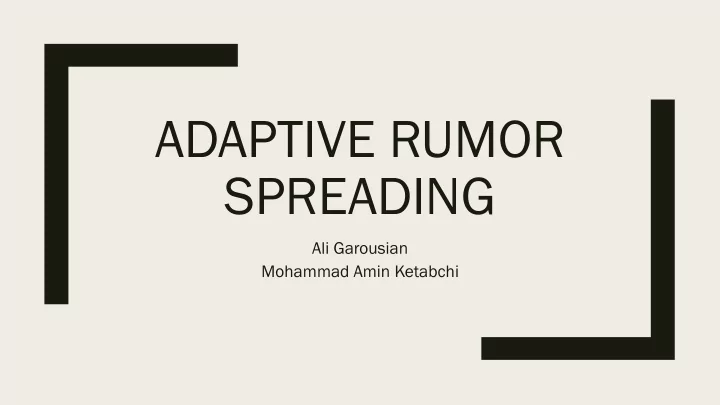

ADAPTIVE RUMOR SPREADING Ali Garousian Mohammad Amin Ketabchi
Introduction
Introduction ■ Rumors in social networks: contents, updates, new technology, etc. ■ In viral marketing campaigns, the selection of vertices is crucial. ■ An agent (service provider) wants to efficiently speed up the communication process.
Introduction: Rumor spreading ■ Models differ in time and communication protocol. ■ In simple cases, the time to activate all the network is mostly understood. ■ Even in random networks the estimates are logarithmic in the number of nodes.
Introduction: Opportunistic networks ■ We have an overload problem, an option is to exploit opportunistic communications. ■ A fixed deadline scenario has been studied heuristically along with real large-scale data.
The model ■ Every pair of nodes can meet and gossip according to a Poisson process of rate 𝜇/𝑜
The problem ■ Constrains: – There is a unit cost for pushing the rumor. – Opportunistic communications have no cost. – At time 𝜐 all of the graph must be active. ■ Goal: – We want a strategy that minimizes the overall number of pushes.
Adaptive and non-adaptive ■ A non-adaptive strategy pushes only at times t = 0 and t = 𝜐 . ■ An adaptive strategy may push at any time, with the full knowledge of the process’ evolution.
Main result ■ Define the adaptivity gap as the ratio between the expected costs of non-adaptive and adaptive. ■ Theorem: – In the complete graph the adaptivity gap is constant.
Non-adaptive ■ Optimal non-adaptive pays almost the same at t = 0 and at t = 𝜐 . ■ Non-adaptive does not push more than 𝑜/2 rumors. Therefore, neither adaptive.
Non-adaptive 1+𝑝 1 𝑜 ■ It is shown that 𝑣 𝑙 𝑢 = 𝑜−𝑙 ∗𝑓 𝜐−𝑢 + 𝑝(1) , where 𝑣 𝑙 𝑢 shows the expected number 1+ 𝑙 of pushes needed at the end if there are k active nodes at time t. ■ Optimal non-adaptive pick is such that 𝑜 𝑙 𝑂 = 1 + 𝑝 1 ∗ 𝑏𝑜𝑒 𝑣 𝑙 𝑂 0 = 𝑙 𝑂 (1 + 𝑝 1 ) 𝜐 1 + 𝑓 2
Big deadline: 𝜐 ≥ (2 + 𝜀) log 𝑜 ■ Starting from a single active node, the time until everyone is active is 2 log 𝑜 + 𝑃(1) . ■ The time is exponentially concentrated. ■ Just starting with one node has cost 1 + 𝜁 , therefore adaptivity does not help.
Small deadline: τ ≤ 2 log log 𝑜 ■ A Poisson process of unit rate gives the randomness. 𝑇 𝑗+1 −𝑇 𝑗 ■ Given the points 𝑇 𝑗 and 𝑇 𝑗+1 , the rescaling is the inter-arrival time. 𝜇 𝑗 ■ A push can be seen as adding a point.
Small deadline (cont.): τ ≤ 2 log log 𝑜 ■ A clairvoyant strategy knows the realization, therefore outperforms adaptive. ■ It’s shown that optimal clairvoyant adds points only at the beginning. ■ Clairvoyant chooses the best number of initial pushes, given the realization.
Small deadline (cont.): τ ≤ 2 log log 𝑜 ■ Say we start with k initial pushes. – We know the inter-arrival distributions. 𝑜 – We know the non-adaptive cost; it pays Ω 𝑚𝑝𝑜 ■ Lemma: 1 – Clairvoyant is considerably better than non-adaptive with probability at most 𝑜 2 ■ In this case we can prove the gap to be 1 + 𝑝(1) .
Other deadlines ■ Insight: adaptive interferes when the cost of pushing is less than or equal to that of not pushing, i.e., 1 + 𝑑𝑝𝑡𝑢 𝑙 + 1 𝑏𝑑𝑢𝑗𝑤𝑓 𝑜𝑝𝑒𝑓𝑡 ≤ 𝑑𝑝𝑡𝑢 𝑙 𝑏𝑑𝑢𝑗𝑤𝑓 𝑜𝑝𝑒𝑓𝑡 (∗) ■ A relaxed strategy pushes for free, but with certain conditions. – Pushes only when (*) holds. – Does not push after 𝑜/2 . ■ Relaxed outperforms adaptive.
General model ■ We need to keep track of the set of active nodes. ■ Even the non-adaptive problem is difficult in this setting!
Conjectures and open problems ■ Is there a broader class of graphs maintaining the constant gap result? ■ Additive gap for the complete graph is constant, i.e., 𝑑𝑝𝑡𝑢 𝑂𝐵 − 𝑑𝑝𝑡𝑢 𝐵 = 𝑃(1).
Any questions?
Recommend
More recommend